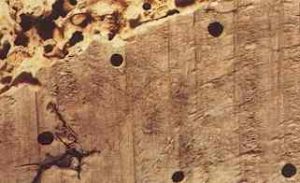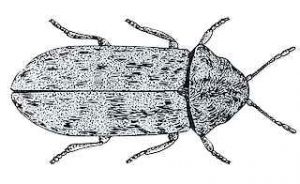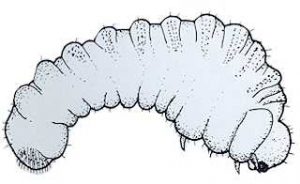The Deathwatch Beetle – Xestobium rufovillosum
Next Beetle >>
Habitat

General: Sapwood and heartwood of partially decayed hardwoods, chiefly oak.
Solid timber: Often found in historic buildings where large quantities of oak or elm are used structurally. Softwoods are rarely attacked except when in contact with infested hardwood. Dampness is essential for establishment and promoting rapid development, although attacks can continue, albeit slowly, in drier timber.
Found particularly in areas prone to dampness – wall plates, ends of floor joists, lintels and other built-in timbers. Damage is often extreme in concealed bearing ends of timbers inserted into damp walls. In conjunction with fungus may hollow out centre of large section beams.
Damage Charactaristics

Emergence holes: Circular, 3 mm diameter
Tunnels: Circular, 3 mm diameter. Often extensive, random orientation, mainly in direction of grain. Bore dust cream-coloured, disc-shaped pellets. Gritty when rubbed between fingers.
Likely misidentifications: Common furniture beetle, bostrychid powderpost beetle, bark borer beetle, wood wasp, page dermestid beetle, tenebrionid beetle, bees or wasps, marine borer.
Remedial Treatments:
- Usual Organic solvent or paste.
- Use pressure injection or gravity feed application to large, well-infested impermeable timbers.
- Inspect all structural timbers and replace or support any showing structural weakening.
- Take measures to reduce dampness.
- NOTE: internal cavities in beams require careful inspection and injection of preservative.
- Other types – Smokes.

Appearance
 Larva
Larva
Insect Characteristics and Location:
Adult: 6 – 9 mm long, chocolate brown. Patches of yellow hairs. Similar shape to Dermestids but slightly different antennae and thorax (see drawing). Found on or beneath timbers, March to June, particularly in warm weather when they may be heard tapping.
Next Beetle >>
